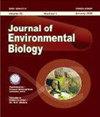Identifying pollution scavenging potential of perennial plants growing in Maitreyi College Campus, University of Delhi
IF 0.7
Q4 ENVIRONMENTAL SCIENCES
引用次数: 0
Abstract
Aim: Air Pollution Tolerance Index (APTI) represents the potential of a plant to combat air pollution. In the present study, APTI value of 77 perennials growing in the Maitreyi College Campus, New Delhi was calculated, and these plants were classified into tolerant and sensitive species. Methodology: APTI was calculated by assessing four physiological and biochemical parameters, pH, Relative Water Content (RWC), Total Chlorophyll (TCh), and Ascorbic Acid (AA). Results: The highest APTI was observed in Musa sp. (10.52) indicating it to be the most tolerant, while the lowest in Aegle marmelos (1.93), showing it to be the most sensitive for pollution. Results showed Musa sp., Salmelia sp., Terminalia arjuna, Murraya exotica, Hamelia patens, Ravenala madagascariensis, Ficus racemosa, Cascabela thevetia, Eugenia uniflora, Nyctanthes arbortristis to have good potential in reducing air pollution in a sustainable manner. Species such as Aegle marmelos, Plumeria rubra, Dracaena, Carissa carandas, Eucalyptus sp. were sensitive to air pollution. Interpretation: Analysis of results suggested the importance of APTI analysis in a campus for cataloging the pollution tolerant and sensitive plants. The pollution tolerant plants could be used for the green belt formation, while plants, which are sensitive to pollution can be used as an indicator of pollution. Moreover, mapping and compilation of information of trees (deciduous and evergreen) and shrubs growing in the campus helped in documenting the rich flora of the campus with pollution tolerance potential. Key words: Air Pollution, Air Pollution Tolerance Index, Air quality, Trees确定德里大学梅特雷伊学院校园内生长的多年生植物的污染清除潜力
目的:空气污染耐受指数(APTI)代表一种植物对抗空气污染的潜力。本研究计算了生长在新德里 Maitreyi 学院校园的 77 种多年生植物的 APTI 值,并将这些植物分为耐受性物种和敏感性物种。研究方法:通过评估 pH 值、相对含水量(RWC)、总叶绿素(TCh)和抗坏血酸(AA)这四个生理生化参数来计算 APTI 值。结果麝香草(Musa sp.)的 APTI 最高(10.52),表明其耐受性最强,而芒果(Aegle marmelos)的 APTI 最低(1.93),表明其对污染最敏感。结果表明,Musa sp.、Salmelia sp.、Terminalia arjuna、Murraya exotica、Hamelia patens、Ravenala madagascariensis、Ficus racemosa、Cascabela thevetia、Eugenia uniflora、Nyctanthes arbortristis 具有以可持续方式减少空气污染的良好潜力。Aegle marmelos、Plumeria rubra、Dracaena、Carissa carandas、Eucalyptus sp.等物种对空气污染敏感。解释结果分析表明,APTI 分析对校园内耐污染植物和敏感植物的分类非常重要。耐污染植物可用于绿化带的形成,而对污染敏感的植物则可用作污染指标。此外,绘制和汇编校园内生长的乔木(落叶和常绿)和灌木信息,有助于记录校园内具有耐污染潜力的丰富植物群。关键字空气污染、空气污染耐受指数、空气质量、树木
本文章由计算机程序翻译,如有差异,请以英文原文为准。
求助全文
约1分钟内获得全文
求助全文
来源期刊

Journal of environmental biology
ENVIRONMENTAL SCIENCES-
CiteScore
1.70
自引率
0.00%
发文量
92
审稿时长
3 months
期刊介绍:
Information not localized
 求助内容:
求助内容: 应助结果提醒方式:
应助结果提醒方式:


